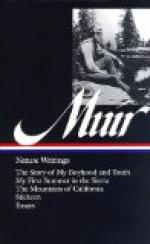Another extraordinary shooting-affair happened one summer morning shortly after daybreak. When I went to the stable to feed the horses I noticed a big white-breasted hawk on a tall oak in front of the chicken-house, evidently waiting for a chicken breakfast. I ran to the house for the gun, and when I fired he fell about halfway down the tree, caught a branch with his claws, hung back downward and fluttered a few seconds, then managed to stand erect. I fired again to put him out of pain, and to my surprise the second shot seemed to restore his strength instead of killing him, for he flew out of the tree and over the meadow with strong and regular wing-beats for thirty or forty rods apparently as well as ever, but died suddenly in the air and dropped like a stone.
We hunted muskrats whenever we had time to run down to the lake. They are brown bunchy animals about twenty-three inches long, the tail being about nine inches in length, black in color and flattened vertically for sculling, and the hind feet are half-webbed. They look like little beavers, usually have from ten to a dozen young, are easily tamed and make interesting pets. We liked to watch them at their work and at their meals. In the spring when the snow vanishes and the lake ice begins to melt, the first open spot is always used as a feeding-place, where they dive from the edge of the ice and in a minute or less reappear with a mussel or a mouthful of pontederia or water-lily leaves, climb back on to the ice and sit up to nibble their food, handling it very much like squirrels or marmots. It is then that they are most easily shot, a solitary hunter oftentimes shooting thirty




